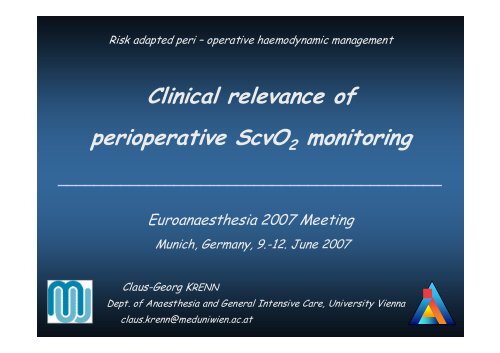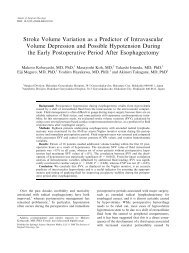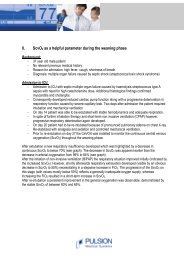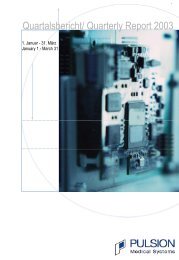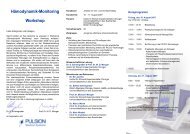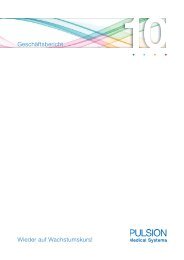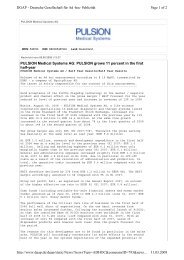SvO2 = SaO2
SvO2 = SaO2
SvO2 = SaO2
You also want an ePaper? Increase the reach of your titles
YUMPU automatically turns print PDFs into web optimized ePapers that Google loves.
Risk adapted peri – operative haemodynamic management<br />
Clinical relevance of<br />
perioperative ScvO 2 monitoring<br />
___________________________________________<br />
Euroanaesthesia 2007 Meeting<br />
Munich, Germany, 9.-12. June 2007<br />
Claus-Georg KRENN<br />
Dept. of Anaesthesia and General Intensive Care, University Vienna<br />
claus.krenn@meduniwien.ac.at
standard hemodynamic monitoring<br />
___________________________________________________<br />
31 of 36 medical shock<br />
patients:<br />
– resuscitated to normal<br />
MAP and CVP<br />
– have global tissue hypoxia<br />
(Scv02 < 70% ) and<br />
– lactate >2 mmol/L<br />
Rady, AJEM 1994
Rady, AJEM 1994<br />
MAP<br />
[mmHg]<br />
180<br />
150<br />
120<br />
90<br />
60<br />
30<br />
Standard hemodynamic monitoring<br />
might be not enough<br />
to assess tissue oxygenation in<br />
patients at risk !!!<br />
n= 1232<br />
DO2 ml*m-2 *min-1 100 300 500 700 900 1100
Für die Entwicklung der Lehre vom Kreislauf war es gewiss<br />
ein Verhängnis, dass das Stromvolumen verhältnismäßig so<br />
umständlich, der Blutdruck aber gar so leicht bestimmbar ist -<br />
deshalb gewann das Blutdruckmanometer einen geradezu<br />
faszinierenden Einfluss, obwohl die meisten Organe gar<br />
nicht Druck, sondern Stromvolumen brauchen.<br />
A. Jarisch<br />
„Kreislauffragen“ ; 1928
The conventionally measured variables such as bl od<br />
pressure, heart rate and urine output were of little<br />
prognostic value.<br />
Only variables related to volume and flow<br />
(blood volume, cardiac output, oxygen delivery and consumption)<br />
had a significant prognostic value.<br />
W. C. Shoemaker 1979
Macrohemodynamics<br />
═<br />
regional blood flow
Macrohemodynamics<br />
═<br />
regional blood flow
Macrohemodynamics<br />
═<br />
regional blood flow<br />
need for a relieable clinically applicable and<br />
useful indicator of adequate tissue oxygenation
Macrohemodynamics<br />
═<br />
regional blood flow<br />
need for a relieable clinically applicable and<br />
useful indicator of adequate tissue oxygenation<br />
monitoring should be dynamic -<br />
interventions immediately affect parameter
physiologic key question of oxygen transport<br />
___ __ __ __ __ __ __ __ __ __ __ __ __ __ __ __ __ __ __ __ __ __ __ __<br />
… adequacy or mismatch
the controversy of increasing O 2 transport<br />
___________________________________________________________<br />
10<br />
5<br />
0<br />
-5<br />
-10<br />
-15<br />
-20<br />
-25<br />
-30<br />
0 2 4 6 8 10 12 16 20 24<br />
„goal directed therapy“<br />
GDT<br />
… increase O 2 delivery to (supra)normal values !!!<br />
WC Shoemaker et al. 1973, Arch Surg 106
the controversy of increasing O 2 transport<br />
____________________________________________________<br />
Hayes et al., N Engl J Med 1994
ScvO 2<br />
___ __ __ __ __ __ __ __ __ __ ___<br />
VO 2 DO 2 DO 2 VO 2<br />
Stress PaO 2 PaO 2 Anesthesia<br />
Pain Hb Hb Hypothermia<br />
Shivering CO CO<br />
Fever Hypovolemia
Oxygen delivery (DO 2)<br />
______________________________<br />
1) not necessarily increases<br />
oxygen consumption<br />
2) why not measure<br />
oxygen consumption ?<br />
3) use mixed venous oxygen<br />
satturation as marker<br />
of oxygen consumption<br />
SvO 2
Meta – analysis of hemodynamic optimization<br />
________________________________________________________________
Meta – analysis of hemodynamic optimization<br />
___________________________________________________________
from SvO 2 to mixed central venous O 2 satturation<br />
___________________________________________________________________<br />
.<br />
ScvO 2<br />
SvO 2
from SvO 2 to mixed central venous O 2 satturation<br />
___________________________________________________________________<br />
.<br />
V. cava sup.<br />
- before the<br />
right heart<br />
ScvO 2<br />
SvO 2
early goal directed therapy<br />
___ __ __ __ __ __ __ __ __ __ __ __ __ __ __ __ __ __ _<br />
E. Rivers et al.;<br />
N Engl J Med 2001
early goal directed therapy<br />
___ __ __ __ __ __ __ __ __ __ __ __ __ __ __ __ __ __ _
early goal directed therapy<br />
___ __ __ __ __ __ __ __ __ __ __ __ __ __ __ __ __ __ _<br />
E. Rivers et al.;<br />
N Engl J Med 2001
ScvO 2 - continuous measurments<br />
_________________________________________________<br />
continuous fiberoptic<br />
venous oxymetry
ScvO 2 - continuous measurments<br />
_________________________________________________
is ScvO 2 a valuable parameter for monitoring ?<br />
_________________________________________________________<br />
� in all patients ?<br />
� in all clinical<br />
situations ?<br />
� without endangering<br />
by itself ?<br />
� with impact on<br />
prognosis ?
ScvO 2 in critically ill patients<br />
___ __ __ __ __ __ __ __ __ __ __ __ __ __ __ __ ___<br />
� 61 patients, paired measurment on admission<br />
� correlation coefficient 0.945<br />
� both parameters are closely related and<br />
interchangeable for the first evaluation<br />
Ladakis et al. Respiration 2001:68
ScvO 2 in critically ill patients<br />
_____________________________________________<br />
� continuously measured in high-risk patients,<br />
paired measurment<br />
Reinhart et al. ICM 2004: 30
ScvO 2<br />
___ __ __ __ __ __ __ __ __ __ ___<br />
� was unaffected by changes in<br />
physiologic variables (pH, temp., a.s.o.)<br />
� averaged 7 ± 4 % higher<br />
� paralleled SvO 2 in more than 90%<br />
� correlation coeff. r = 0.96
ScvO 2 in septic shock patients<br />
___ __ __ __ __ __ __ __ __ __ __ __ __ __ __ __ __ __<br />
� 16 patients, paired measurments over 24 h<br />
Varpula et al., ICM 2006; 32:1336
ScvO 2<br />
___ __ __ __ __ __ __ __ __ __ ___<br />
� difference between SvO 2 and ScvO 2<br />
varies considerably over time<br />
� ScvO 2 being higher at all TP<br />
� ScvO 2 inadequate tool to estimate the<br />
flow-weighted oxygen balance of the whole<br />
body (SvO 2 )<br />
� but accurately reflects hypovolemia
ScvO 2 in critically ill patients<br />
______________________________________________<br />
� 53 patients, surgical and medical<br />
� calculating VO 2 on basis of ScvO 2 produced<br />
unaccaptable large errors<br />
� difference might be attributed to mixing with<br />
coronary sinus blood<br />
Chawla et al., CHEST 2004:126
ScvO 2 in perioperative patients at risk<br />
__________________________________________________<br />
� Morbidity<br />
� Increased length of hospital stay<br />
� Mortality
high risk patients<br />
__________________________________<br />
� Emergency abdominal aortic surgery<br />
� Trauma, such as fractured neck of femur<br />
� Neurological<br />
� Cardiovascular<br />
� severe valvular heart disease<br />
� aortic dissection<br />
� Gastrointestinal<br />
� Colon resection<br />
� large and small bowel obstruction<br />
� Pancreatic surgery
Reason for being high risk<br />
________________________________________<br />
� Co-morbidity<br />
� elderly patients with significant medical problems<br />
� Type of surgery<br />
� often long procedure with significant blood loss<br />
fluid shift, electrolyte and nutritional problems<br />
and possibility of post-op pain (effects breathing)<br />
� abdominal surgery is associated with physiological<br />
stress response<br />
� Emergency or elective<br />
� Patients who present with urgent emergency<br />
cases have worse outcomes
ScvO 2<br />
___ __ __ __ __ __ __ __ __ __ ___<br />
� fluctuations occur in the post-op period<br />
� not only associated with DO 2 but also<br />
related to oxygen consumption<br />
� ScvO 2 changes are independently<br />
associated with postoperative complications<br />
ScvO 2 lowest value (cut off 64 %) was<br />
significantly lower in patients who<br />
developed complications
• absolute values<br />
differed unaccaptable<br />
r = 0.76<br />
• however the trend was<br />
clinically acceptable as<br />
substitute of SvO 2
ScvO 2 in cardiac surgical patients<br />
___ __ __ __ __ __ __ __ __ __ __ __ __ __ __ __ __ __ __ _<br />
� 60 patients, 5 TP, 300 paired measurments<br />
Sander et al. ICM 2007
ScvO 2<br />
___ __ __ __ __ __ __ __ __ __ ___<br />
� weak correlation over all measurments<br />
� more pronounced association in<br />
values below 70%<br />
� attributed to increase of oxygen extraction<br />
rate of splanchnic circulation in the course of<br />
ACBP crafting<br />
� ScvO 2 might overestimate SvO 2<br />
� thus only high values can exclude tissue hypoxia
� Goal directed therapy – setting ,<br />
aiming at adequate DO 2 by improving CO<br />
(stroke volume optimization) by<br />
fluid and catecholamine administration<br />
� resulted in reduced mortality and HLoS
ScvO 2<br />
___ __ __ __ __ __ __ __ __ __ ___<br />
� reflects the degree of oxygen extraction<br />
from the upper part of the body including<br />
the brain<br />
� values are slightly higher than SvO 2<br />
� difference to SvO 2 might vary with<br />
cardiovascular insufficiency<br />
� thus in case of low SvO 2 it should not be<br />
used alone but in combination with other<br />
markers
Nguyen et al., Crit Care Med 2007, 35
… perfusion –<br />
deficit ?<br />
practical aproach ?<br />
________________________________<br />
advanced<br />
monitoring<br />
global or regional<br />
problem ?<br />
S cvO 2 ? EGDT
Conclusion ScvO 2 - monitoring<br />
_______________________________________<br />
� identify high risk patients and implement<br />
ScvO 2 monitoring early - as easy as with<br />
insertion of the central venous catheter
Conclusion ScvO 2 - monitoring<br />
_______________________________________<br />
� implement early in high risk patients<br />
� check signs of reduced tissue perfusion<br />
s.a.: complete hemodynamic evaluation<br />
(CO, stroke volume ~ variation, GEDV,<br />
lactate, PDR of ICG, diuresis)
Conclusion ScvO 2 - monitoring<br />
_______________________________________<br />
� implement early in high risk patients<br />
� check signs of reduced tissue perfusion<br />
� rely on the course targeting your<br />
hemodynamic goals which in almost all cases<br />
mirrors the course of SvO 2
Conclusion ScvO 2 - monitoring<br />
_______________________________________<br />
� implement early in high risk patients<br />
� check signs of reduced tissue perfusion<br />
� rely on the course<br />
� treat according to a standardized algorythm<br />
aiming at adequate (regional) perfusion
focus on : „early and goal directed“<br />
___________________________________________________________________________
Gemischtvenöse Sättigung <strong>SvO2</strong><br />
• <strong>SvO2</strong> = <strong>SaO2</strong> – VO2<br />
folgt aus der Umwandlung von<br />
• VO2 = CO × (CaO2 – CvO2)<br />
Sauerstoffverbrauch berechnet<br />
CO ⋅ Hb ⋅ 1,34
ScvO 2<br />
___ __ __ __ __ __ __ __ __ __ ___<br />
� adequately reflects hypovolemia<br />
� only high values [ ›70%] can exclude<br />
inadequate oxygen delivery<br />
� is no general estimate of SvO 2


